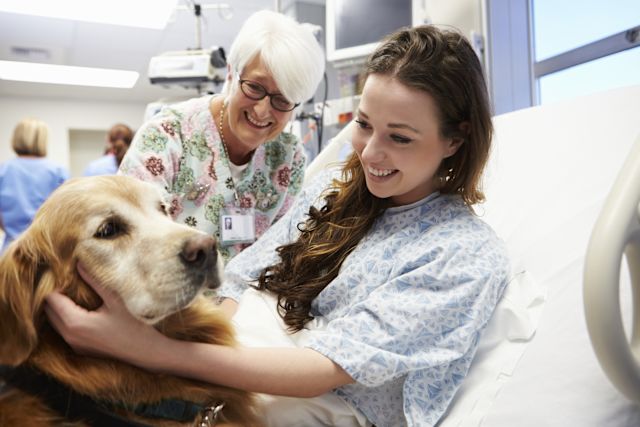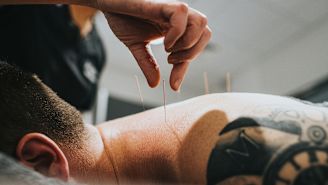Updated on June 26, 2023.
Recuperating in a hospital, nursing home, or other healthcare facility can be a stressful experience. Lights and ambient noises can disrupt your sleep, there could be crowds, and the environment may feel hectic. Tests and treatments can sometimes be painful. You might miss getting the nutrition you need, and you may not be as mobile or independent as you’re used to.
All these factors may leave you feeling tired and helpless. They can also stimulate physical and psychological stress responses in your body, which may actually slow the healing process—both in the hospital and after you leave it.
Getting plenty of rest, eating right, taking your medicine, and following your healthcare provider’s (HCP) recovery instructions will help the healing process following surgery or injury. But those measures don't always help you deal with the stress of being a patient. Is there more to getting back on your feet than following HCP orders?
Soothing your psyche
Research suggests it may be worth exploring some innovative avenues to wellness and recovery as a complement to traditional post-surgery care. They might even help get you back on your feet faster by minimizing psychological and physical stress.
A holistic road to recovery may include spending time in (or looking at) green spaces, listening to music, or spending time with your favorite furry or feathered friend. The next time you are on the mend, first and foremost, follow the recommendations provided by your HCP. Then, consider trying the following approaches to soothe your psyche and aid your healing process:
Look out the window
Access to natural light and an outside view that you like—especially a green, leafy one—may help you heal faster. Research suggests that views of nature have been associated with more relaxation, fewer minor postsurgical complications, and shorter stays in both the ICU and the hospital.
To give a few examples:
- A 2022 study published in European Psychiatry found that for psychiatric inpatients, window views with green trees and bright light significantly lowered the length of their hospital stay.
- A 2019 study published in the International Journal for Quality in Health Care looked at 296 patients recovering from C-sections. Those who felt highly satisfied with their window’s view tended to have lower pain, need less pain medication, and experienced less interference of pain on their quality of life, relationships, and mood.
- A 2020 review in Complementary Therapies in Medicine looked at many studies and found a positive relationship between exposure to nature and lowered physiological stress.
Now, some medical and residential facilities cultivate a garden as part of their recovery program. According to the American Horticultural Therapy Association, engaging with a garden through horticultural therapy techniques can help you regain strength, coordination, balance, and endurance, as well as improve memory, language skills, and cognitive abilities.
If you can't see greenery through your window, bring it indoors with house plants and flowers. Even looking at pictures of nature can help lower your physical stress levels. A 2019 review in the International Journal of Environmental Research and Public Health found that viewing pictures or videos of nature leads to physiological relaxation.
Experience the color of health
While the idea that colors and colored light can affect living beings is pretty old, the scientific field of color psychology is newer. The general theory is that colors can activate and influence feelings in people and stimulate their imagination and memory. Research in this field has suggested that the color blue is linked to both calm and alertness.
Treatment using red light has been shown in the past to reduce arthritis pain, and green light may reduce pain with migraines and fibromyalgia. Both light therapy and color psychology are complex areas of study, and more research is needed to be able to offer more certainty. Still, it might be helpful to take note of which colors affect your own mood and engage with those that make you feel brighter and calmer.
Fill your days with music
The next time you are recovering, you may want to create a playlist of relaxing music.
Music has been used by countless cultures for thousands of years to alleviate suffering and enhance well-being. Today, music therapy is widely recognized as a noninvasive, cost-effective complement to pain medication.
A 2021 review published in Cureus looked at 13 studies and found that music therapy significantly reduced both pain and anxiety for orthopedic surgery patients. An earlier review from 2016 in the Journal of Music Therapy looked at 97 studies and found that music is an effective pain reducer, eases pain-based emotional distress, and lowers heart rate and blood pressure. Multiple other studies have found that listening to music after an operation can lower stress and pain.
There are many theories for how this works. Most seem to agree that listening to music causes beneficial physiological changes in patients, including changed neuronal pathways, triggered dopamine responses, lowered blood pressure, and reduced heart rate. There’s also evidence that patients who listen to music before or after a medical procedure are likely to be more relaxed, perceive less pain, and require less medication than patients who don't listen to music.
During your recovery, you can choose a music playlist that is personalized and works to help you feel relaxed. If you’re recovering in the hospital, you can try to alleviate environmental stress with earphones playing music. If you have access to a music therapist, they can help you engage with works of music in a healing way.
Some facilities provide music therapy as part of a treatment plan. But because it is a relatively new option, it may not be offered in your area, or it may not be covered by insurance. Check with your provider to determine if music therapy is included in your insurance policy.
To learn more about music therapy, or to find a licensed provider near you, visit the American Music Therapy Association.
Spend time with a furry friend
Animals bring a special kind of love and comfort to many people. Hospitals, nursing homes, schools, and healthcare facilities are taking note of a growing body of scientific evidence suggesting animals can help patients recover. A number of studies and reviews have found that animals accomplish this by improving patients’ pain, anxiety, depression, stress, and by lowering their blood pressure.
In one 2018 study published in PloS One, hospitalized children with cancer who were given animal-assisted therapy with two dogs had less pain and stress, as well as a lower risk of depression. Their caregivers also had less anxiety and tension.
After surgery, animal-assisted therapy has even been shown to help patients become more wakeful and active after anesthesia.
Animals also help create a more sociable environment. In a 2018 study in Patient Education and Counseling, it was noted that when pets were able to be with their hospitalized person, their presence prompted connection and stories to be shared between staff, patients, and families. In this way stronger relationships can be built between all these groups of people, which can lead to empathy, compassion, understanding, and more personalized care.
Although most hospitals still won't allow family pets, if you are recovering at home, feel free to spend lots of time petting your favorite four-legged friend.
More ways to boost healing
There are other ways to set up your space, whether in the hospital or at home, for optimal comfort and healing. Consider these strategies:
- Keep it simple. Remove clutter and organize all medications and treatment paraphernalia.
- Give it meaning. Place sentimental objects or photos of loved ones close at hand for a sense of familiarity and comfort.
- Make it pretty. Hang works of art on the walls and surround yourself with soothing fabric designs.







